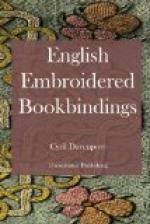In the History of the Worthies of England, by Thomas Fuller, there is a short note about Little Gidding, and he says about the ladies there that ’their own needles were emploied in learned and pious work to binde Bibles.’ This note and the mention of needles may have perhaps given the start to the belief that embroidered work was intended, but in all probability it only refers to the sewing of the leaves of the books upon the bands of the back, which is done with needle and thread. Moreover, the ladies of Little Gidding did actually sew the backs of their books in a needlessly elaborate way, putting in ten or twelve bands where three or four would have been ample. I also think that if embroidery had been intended by the sentence above quoted, it would have been more clearly mentioned. To ‘emploie needles to bind Bibles’ is hardly the description one would expect if the meaning was that when bound the Bibles were covered in embroidered work; but it may be safely interpreted as it is written, the sewing being a most important part of a bookbinding, and one likely to be much thought of by amateur binders, as the nieces of Nicholas Ferrar were.
The attribution of embroidered bindings to Little Gidding may also have been strengthened by the fact that many of the bindings made there are in velvet, the ornamentation on which, though it is actually stamped in gold and silver, does to some extent suggest embroidery. Indeed, I have myself heard the remark, on showing one of these books, ’Oh, yes! Embroidery.’
Again, a peculiarity of the Little Gidding books is, generally, their large size, whereas the embroidered books, especially the satin ones, are usually very small.
[Illustration: 49—Psalms. London, 1643.]
One of the embroidered books thus wrongly credited to Little Gidding is a Psalter, printed in London in 1641. It is bound in white satin, very tastefully embroidered, the same design being on each side, and measures 4 by 2 inches. In the centre is a large orange tulip, shading from yellow to red, finely worked in silks in shading-stitch. The stem is outlined in gold cord, and has also symmetrical curves and leaves, some of which are filled in with silver guimp. The flower is enclosed in an ornamental scroll and leaf border, all made with gold threads and twists, and having leaf forms in relief at intervals in silver guimp. The back has five panels, ornamented alternately with guimp scrolls and small spheres of coloured silk. There have been spangles and small pieces of guimp scattered about on the sides and back, but most of them have gone. There are no ties, and the edges of the leaves are gilt, and have a small gauffred pattern upon them.
The design of this book is extremely simple and effective; the fine stitching on the tulip contrasts well with the strong metal border enclosing it. It may be considered a favourable specimen of the commonest type of satin embroidered books of the seventeenth century. It is not in very good condition.




